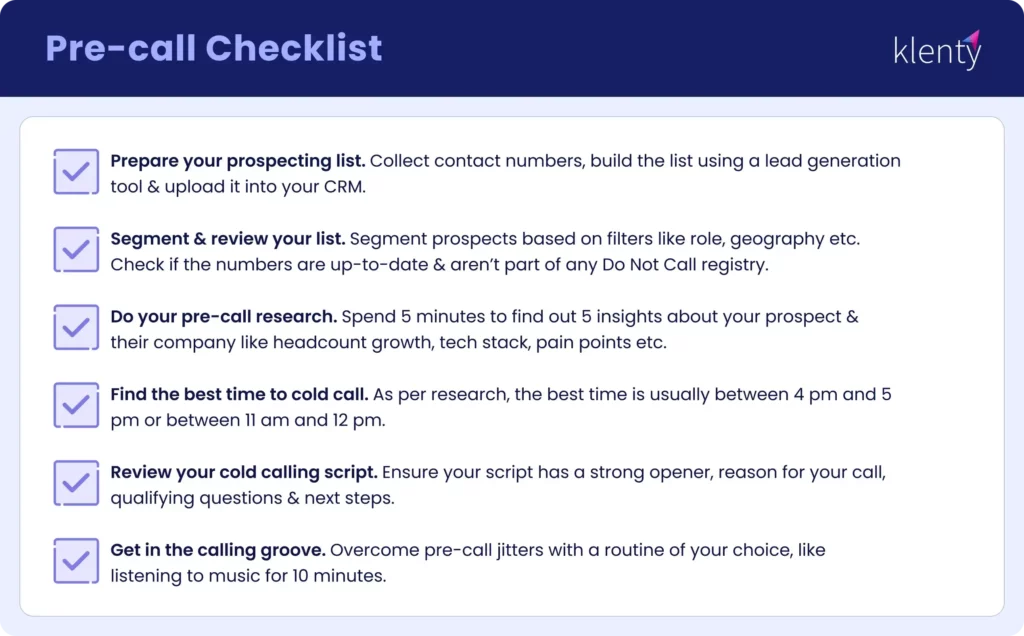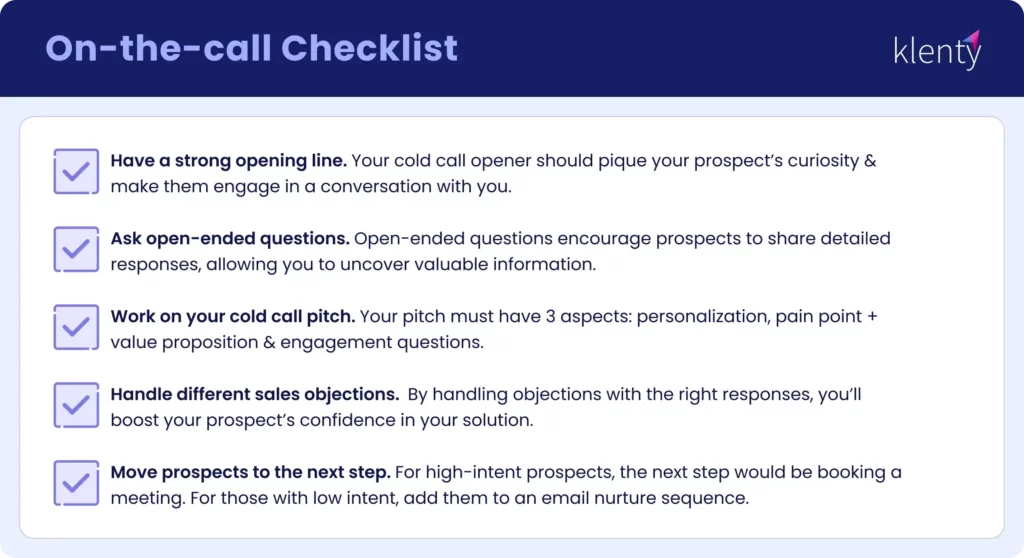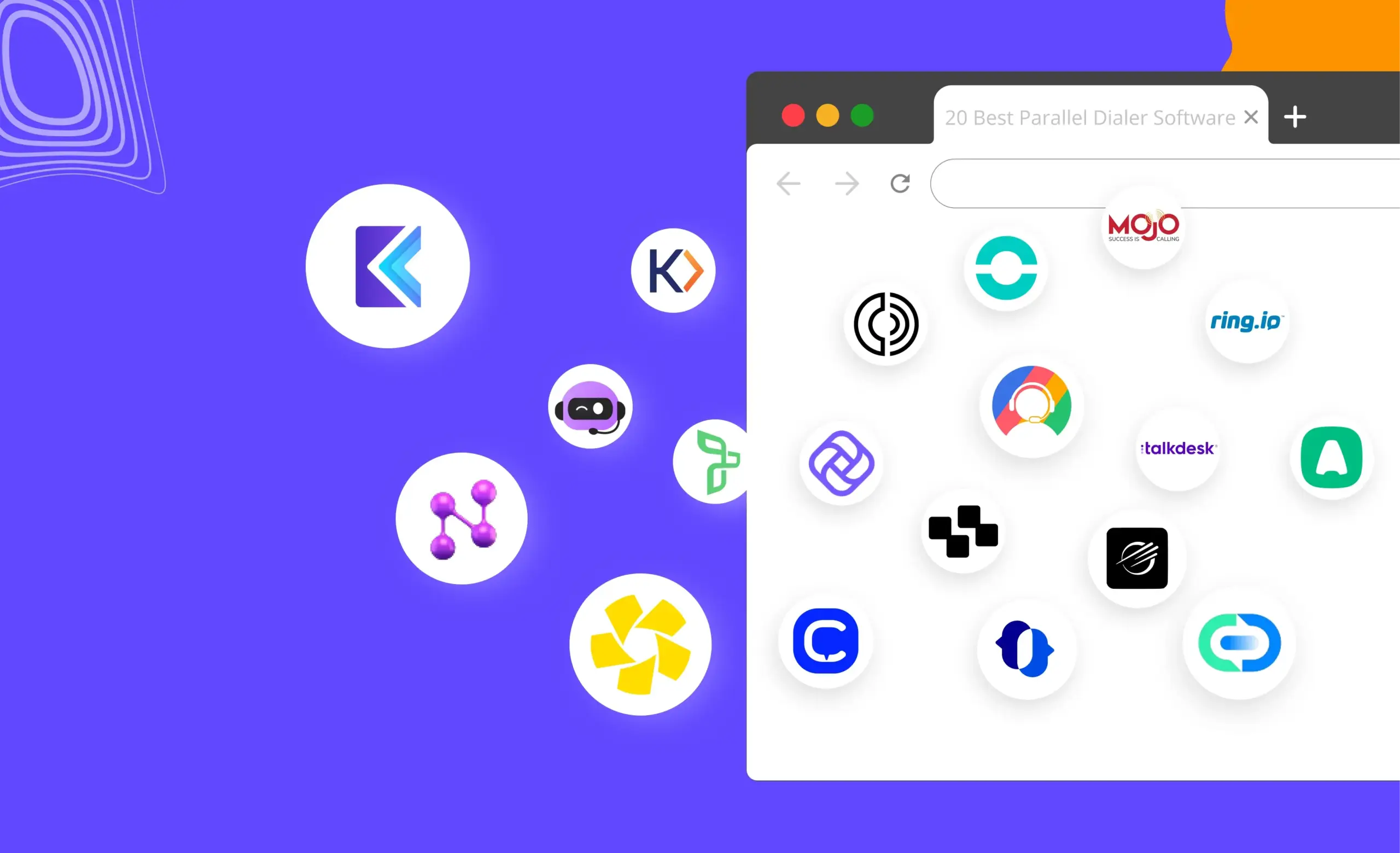If even the idea of cold calling leaves you in sweat, you’re not alone.
63% of sales professionals find cold calling the most difficult part of their job, according to a study by LinkedIn. Another research found that half of B2B sales reps are afraid of making cold calls.
But believe us. Cold calling isn’t all that hard.
All you need is good research, a killer script, and clever follow-ups.
To simplify it further, we present to you our detailed 14-point cold calling checklist. We prepared this checklist based on inputs from sales experts as well as successful reps to help you get maximum value from this.
Let’s dive in and help you turn those dreaded phone calls into a breeze.
Download Now: Free 14-Point Cold Calling Checklist [PDF]
Pre-Call Checklist

1. Prepare Your Prospecting List
The first step in your cold call checklist should be to build a sales prospecting list. Here are 6 simple steps to do this:
- Define your buyers. Start by identifying your Ideal Customer Profile (ICP) based on factors like problems your product solves, your target audience, their industry, job title, etc.
- Collect contact information. Gather important info about your potential buyers like their email addresses, phone numbers, and social media accounts from their company websites or LinkedIn profiles.
- Build your list using lead generation tools. Use lead generation software to automate the process of finding your prospect's contact information and build the list of your prospects. They come with filters tailored to your niche audience and allow you to export the prospect list as a .csv or Excel file.
- Revise your list. Run your cold calling list through list-cleaning software to eliminate duplicate, invalid, and spammy contacts.
- Upload your list into your CRM. Upload your updated cold call list into your CRM to access, edit, and view all information in one place.
- Strategize and begin your outreach. Create an outbound sales strategy based on your business goals, product, and ICP, and start contacting your prospects.
Remember to prioritize prospects with higher conversion potential and allocate your resources accordingly. This way, you can spot the best leads right at the beginning of the sales process, leading to better response rates and a more robust sales pipeline.
2. Segment and Review Your List
Once you have your cold calling list ready, segment and review it carefully to identify high-potential leads and tailor your outreach strategies. Here's how:
- First, ensure that your prospect lists have accurate and up-to-date information.
- Segment your potential customers by role, account, geography, channel, market, or whatever you use in your strategy.
- Check the contact numbers against the TPS or other 'do not contact' (DNC) lists if prospecting in the UK or the EU.
3. Do Your Pre-Call Prospect Research
After reviewing your cold call list, dedicate 5 minutes to gather information about the prospects' businesses, industries, pain points, goals, and any other relevant details. This is sales expert Kyle Coleman's go-to strategy.
To scale personalized outreach and standardize your research, spend 5 minutes to find out 5 insights about a person or account. Spending more time than this will hit your productivity.
Depending on your sales strategy, you can find some vital info about your prospect like:
- Headcount growth: To understand the company's goals, growth rate, and potential needs for your product.
- Tech stack: To learn about their existing tools/software/applications and determine if they can afford your product.
- Job advertisements: To check job descriptions and understand their current processes for different departments and positions.
- Prospect's background: To know how long they've been with the company, recent promotions, etc. to tailor the conversation according to their role and pain points.
- Company's mission: To align your value proposition with their goals and vision.
- Common industry pain points: To identify common challenges in the industry and position your product as the best solution.
4. Find the Best Time to Call
Finding the best time to call your prospects can boost your chances of engagement and success. Research has shown that the best time for cold calling is usually between 4 pm and 5 pm, with the next best window being between 11 am and 12 pm, right before lunch.
On the flip side, early mornings before 8 am are usually off-limits as people are just starting their day.
However, it's important to keep in mind that these timings can vary based on your industry and target audience. So, make sure to track your own industry data and analyze your past call performance to identify the best times to call prospects.
Based on this information, you can schedule call blocks during these peak hours to improve your chances of connecting with prospects.
5. Review Your Cold Calling Script
After finding the best time to call your prospects, the next thing to do is take a look at your cold calling script. A well-crafted script can boost your chances of success by ensuring you cover all bases and communicate effectively with prospects. When reviewing your cold calling script, make sure it has these 4 key elements:
- A strong opener. Use a pattern-interrupting or permission-based opener to catch your prospect's attention and keep them engaged.
- The reason for your cold call. Once you have your prospect's attention, let them know why you're calling. Instead of immediately diving into your product pitch, start a conversation and bring it up organically.
- Qualifying questions. Use a series of qualifying questions to gauge if the prospect is ready to buy. You can base these questions on the SPIN, MEDDIC, NEAT, or GAP model.
- Next steps. Plan your next steps based on the prospect's buying intent. For example, scheduling a meeting for a high-intent prospect or nurturing a low-intent one.
6. Get in the Calling Groove
When cold calling prospects, you might feel the pre-call jitters. And you're not alone—1 out of 2 salespeople fear making cold calls. The key is not letting it impact your outreach efforts. Here are some tips from top-performing SDRs to get over the fear of cold calling:
- Find a quiet corner where you can focus on your calls without any distractions. This is particularly helpful if you don't like others listening in on your conversations.
- Listen to your favorite songs for 10 minutes to relax your mind, boost your energy, and get in the right mindset for productive conversations with prospects.
On-the-Call Checklist

Once you're ready to dial a prospect's number, follow this cold call checklist to stay organized and ensure you cover all the necessary points to maximize the chances of turning them into qualified leads:
7. Have a Strong Cold Call Opener
A banging opener can help you grab your prospect's attention, pique their curiosity, and make them more receptive to the conversation. Here are some of the best cold call opening lines you can use:
- Ask for help: This opener usually gets prospects curious about your ask and helps you give them a lot more context for the call. For example: "Hi, I'm Tim from SaaS Domains, a digital domain renting platform. I'm wondering if you could help me with something."
- Be honest and direct: Don't beat around the bush. Be truthful and upfront about the reason for calling the prospect and ask their permission to continue the conversation. Ashley Dees, a top-performing SDR manager, explains why: "People take it more as a sign of respect, that you're making sure it's okay to continue your pitch when you call them out of the blue." Therefore, you can open the call with something like "Hi, we've never spoken before. I'm Tom from Zeno, a project management software company. Is now a good time to talk?"
- Make the prospect laugh: This approach usually acts as a pattern-interrupter and engages your prospect enough to continue the call. For example, "Hi George, I'm Tim from Zeno, a project management software company. My boss said if I don't make a sale, I'm fired, so if you're not in a buying mood, perhaps you have a job opening."
- Hyper-personalize the opener: Personalizing the opener helps you build rapport with the prospect and makes them more likely to engage with you. For example, "Hi Tom, my name's Ben. We've never spoken before, but we have a mutual connection. I actually attended {prospect's college} in the '15 batch. Which batch were you in?"
8. Ask Open-Ended Questions
Open-ended questions require more than a simple yes or no answer. They encourage prospects to share detailed responses, allowing you to uncover valuable information.
By asking the right questions, you can strike up a meaningful conversation, smoothly transition into your pitch, and book more meetings.
Here are some open-ended cold calling questions you can ask prospects to keep the conversation going:
- “I'll be upfront, this is a cold call. It's up to you: You can either hang up now or let me briefly tell you why I called and then decide.”
- “I was curious to know, do you face [pain points that your product solves] when you try to do [a specific activity of their work process]?”
- “Do you think I could email you the recent case study we did on {prospects competitor}? {Solution} helped them drive {business metric} by 40%?”
- “If you don't mind me asking, are you doing [specific process] manually, or is it automated?”
9. Craft Your Cold Call Pitch Well
Crafting an effective cold call pitch is essential for capturing your prospect's attention and establishing rapport right from the start. Remember, the first 30 seconds of your conversation are critical. They set the tone for the rest of the call and determine if your prospect remains engaged or zones out.
One good way to start is by introducing yourself and your company, followed by a personalized question to show you're interested in understanding the prospect's situation. You can also ask engaging questions to encourage the prospect to actively participate in the conversation.
In short, your pitch must have 3 key aspects:
- Personalization
- Pain point and value proposition
- Engagement questions
Here’s an example of an effective cold calling pitch that incorporates the above 3 aspects:
"Hi John, this is Alex from TechSolutions. We specialize in helping companies optimize their IT infrastructure. Given that your company is in the healthcare sector, managing sensitive patient data securely while ensuring accessibility can be quite challenging. Are you facing any difficulties with data management in your organization?"
10. Handle Different Objections
Objections are just part of the game when it comes to cold calling. They are challenges or concerns raised by prospects and can range from budget constraints to lack of interest. The key is to tackle them head-on so you can keep the conversation going and close the deal.
Let's dive into some common cold-calling objections you might encounter and how you can handle them smoothly:
When faced with this objection, ask the prospect for a better time. This would give them more time to think. For example: "Do you think I can touch base with you sometime later? Do you think your priorities would change?"
While this might not seem like an objection, it is one of the most deceptive objections out there. To turn it around, you can acknowledge their request and provide immediate value to encourage further engagement. For example:
"Absolutely, I'll send you a detailed email. However, I'd love to quickly identify which aspect of Revenue ops is most relevant to you. Could you share what's the biggest problem for your team?"
If the prospect is already using another tool, subtly ask about any challenges they might be facing without directly criticizing the tool. This can help you pitch your product effectively to bridge the gap. For example, "Understood, and it sounds like a great choice. But in your experience of using the current solution, is there any capability you wish it had?"
To handle this objection, politely ask the prospect for a better time to call. Suggest a specific, short duration to make your request more palatable. For example, "No problem. I totally understand what it's like to be interrupted. Would it be better to call you for 5 minutes tomorrow morning at the same time?"
This is one of the most common cold-calling objections and can be handled effectively by highlighting your product's ROI. For example, "[Prospect's Name], that's exactly why I'm calling you. I noticed from your recent LinkedIn post that you're looking to [solve pain point]. Based on your current [tech stack], I estimate that implementing our solution could potentially lead to X% in cost savings over the next [timeframe]. Would you mind taking a look at our solution to see exactly how we can help?"
This objection shows the prospect is unhappy. So, try to diffuse the situation by apologizing, followed by a question like, "Is there a better number at which to reach you? Just so I can make sure to forward any relevant information."
11. Move Them to the Next Step
The last step on your on-the-call checklist is to move the prospect to the next step. After pitching your product and addressing their objections, you should be able to gauge their buying intent. Based on this, you can segment them into 2 categories:
- Prospects with High Buying Intent: If a prospect has shown interest in your pitch and is ready to explore further, it's important to capitalize on this momentum. For such high-intent prospects, the next step would be booking a meeting.
- Prospects with Low Buying Intent: These are prospects that might not be ready to make a purchase just yet. Instead of pushing them for a meeting, nurture them by sharing relevant resources via email.
Post-Call Checklist
Successfully closed a conversation? The job's not over yet. Here are three key steps that you must take post the cold call:

12. Update Your Cold Call Tracking Sheet
After ending the call, the first thing you should do is update your cold call tracking sheet. This sheet records all essential info from each call, allowing you to keep track of all your cold calling activities. You can use it to:
- Monitor progress
- Track follow-up actions
- Identify patterns in prospect responses
A cold call tracking sheet can also help you measure key cold calling metrics such as the number of calls made in a day and the number of quality conversations .
Additionally, the cold calling tracking sheet also makes it easier to record the type of follow-up action required, such as calling on a different day, sharing resources via email, or scheduling a meeting.
13. Plan Your Cold Call Follow-Up
A good chunk of your meetings will not get booked in a single cold call. Therefore, effective and consistent cold call follow-ups are crucial to keep the ball rolling. Here are 7 post-call scenarios you might encounter and how to follow up for each:
- Following Up After Leaving a Voicemail
If you've left a message for the prospect on voicemail, follow it up with an email after a few hours. Mention the time of the voicemail to make it easier for them to go through your message, address their pain point, and let them know that you'll call them back at a different time the next day.
- Following Up After Prospect Requested More Information Over Email
A common objection you might hear from prospects is: "Send me an email with more information." In this scenario, you must share an email within the next 30 to 60 minutes with information such as:
- The context of the call
- The value your solution offers
- A deck on an overview video
- A CTA for a demo call
- Following Up After Prospect Said They Were Busy
If the prospect was busy during your initial call, send them a follow-up email within the next 60 minutes. Mention the reason for calling and ask if they'd be interested in learning about the solution.
- Following Up with Prospects Who are Interested to Book a Meeting
If the call went well and the prospect agreed to a meeting, send them an email with the details of the meeting within 10 minutes of the call. Alternatively, you can share your calendar link with the prospect and ask them to block a time that best works for them.
- Following Up with Prospects Who Wanted to Continue the Discussion Later
If the prospect is interested in your solution but wants to connect at a later date or time, send them an email within 30 to 60 minutes asking if they'll be available at a specific time. Start the email by thanking them for attending the cold call and mention you want to reconnect with them to continue the discussion.
- Following Up with Prospects Who Didn't Pick Up After Several Attempts
If you've tried reaching out to a prospect multiple times despite any luck, send them cold emails instead. Add them to a sales email sequence to send a series of emails over time to get a reply from them.
- Following Up with Prospect Who Wants to Reconnect After a Few Months
If a prospect has asked you to circle back after a few months, send them a follow-up email within the next two hours. Thank them for their interest in your solution and inform them that you'll call them back at the requested time.
14. Analyze Your Cold Call
After you've called all prospects, take time to analyze the recordings of your connected cold calls. This will give you a better idea of what works in your cold call approach and what might need some tweaking. This is also an excellent way to spot any mistakes you may have made and make improvements for future calls.
Look for qualitative factors, such as:
- Tone of voice: Did you talk in an upward or downward inflection
- Pace: Did you talk fast, slow, or at a normal pace
- Objection handling: How effectively were you able to handle objections
- Productivity: Did you follow through on the calls that did not convert?
However, manually listening to recordings can be time-consuming. This is why you need a conversation intelligence tool that can transcribe, summarize, and generate automated reports on your calls.
These tools can help you identify:
- Which cold call openers work the best.
- What part of your call script needs a little tweaking (value proposition, objection handling, etc.)
- Whether you're talking too much or maintaining the right talk-to-listen ratio.
This will enable you to self-evaluate your performance and identify areas of improvement.
Power Through Your Cold Calling Checklist With the Right Tool
As an SDR, you might cold call 50-100 prospects every day. However, this isn’t the only thing you do in prospecting—you’re juggling pre-call research, following up using other channels, and updating your CRM. Managing all these tasks manually can be exhausting. The result? You don’t book enough meetings, and your sales pipeline looks parched.
This is why you need to automate your cold calling process with cold calling software. It can automate mundane tasks like dialling numbers, logging call details into CRMs, scheduling follow-ups, and note-taking so you can reach more prospects and book more meetings.
With a robust cold calling tool like Klenty's Sales Dialer, you can boost your efficiency through features like:
- Parallel dialer. Call up to 5 prospects at the same time.
- AI note-taking. Record calls, take notes, and log them into your CRM automatically.
- 1-click-to-call dialer. Eliminate manual dialing and call prospects in bulk.
- Time zone detection. Call prospects at the right time based on their time zone.
- Local numbers. Use local numbers to build trust and increase your chances of connecting.
- Voicemail drop. Send personalized, pre-recorded voicemails in a single click.
Book a demo now to see Klenty's sales dialer in action!
FAQ
1. How Soon Should You Follow Up After a Sales Call?
2. How Do You Pitch a Product on a Cold Call?
3. How Do You Structure a Cold Call?
- Start with a strong opener
- Ask open-ended questions to understand the prospect's pain points
- Pitch your product as the solution
- Handle the prospect's objections
- End by discussing the next steps





